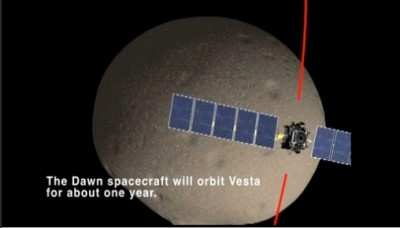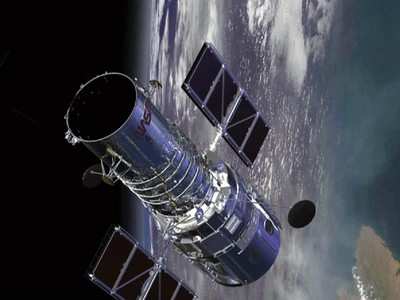Hubble Photos Will Help Determine Orbit Plans
NASA's Hubble Space Telescope has captured images of the large
asteroid Vesta that will help scientists refine plans for the Dawn
spacecraft's rendezvous with the body in July 2011.

Vesta Rendezvous From NASA Animation
Scientists have constructed a video from the images that will
help improve pointing instructions for Dawn as it is placed in a
polar orbit around Vesta. Analyses of Hubble images revealed a pole
orientation, or tilt, of approximately four degrees more to the
asteroid's east than scientists previously thought. This means the
change of seasons between the southern and northern hemispheres of
Vesta may take place about a month later than previously expected
while Dawn is orbiting the asteroid. The result is a change in the
pattern of sunlight expected to illuminate the asteroid. Dawn needs
solar illumination for imaging and some mapping activities.
"While Vesta is the brightest asteroid in the sky, its small
size makes it difficult to image from Earth," said Jian-Yang Li, a
scientist participating in the Dawn mission from the University of
Maryland in College Park. "The new Hubble images give Dawn
scientists a better sense of how Vesta is spinning because our new
views are 90 degrees different from our previous images. It's like
having a street-level view and adding a view from an airplane
overhead."
The recent images were obtained by Hubble's Wide Field Camera 3
in February. The images complemented previous ones of Vesta taken
from ground-based telescopes and Hubble's Wide Field and Planetary
Camera 2 between 1983 and 2007. Li and his colleagues looked at 216
new images -- and a total of 446 Hubble images overall -- to
clarify how Vesta was spinning. The journal Icarus recently
published the report online.

Hubble Space Telescope NASA Image
"The new results give us food for thought as we make our way
toward Vesta," said Christopher Russell, Dawn's principal
investigator at the University of California, Los Angeles. "Because
our goal is to take pictures of the entire surface and measure the
elevation of features over most of the surface to an accuracy of
about 33 feet, or the height of a three-story building, we need to
pay close attention to the solar illumination. It looks as if Vesta
is going to have a late northern spring next year, or at least
later than we planned."
Launched in September 2007, Dawn will leave Vesta to encounter
the dwarf planet Ceres in 2015. Vesta and Ceres are the most
massive objects in the main asteroid belt between Mars and Jupiter.
Scientists study these celestial bodies as examples of the building
blocks of terrestrial planets like Earth. Dawn is approximately 134
million miles away from Vesta. Next summer, the spacecraft will
make its own measurements of Vesta's rotating surface and allow
mission managers to pin down its axis of spin.
"Vesta was discovered just over 200 years ago, and we are
excited now to be on the threshold of exploring it from orbit,"
said Bob Mase, Dawn's project manager at NASA's Jet Propulsion
Laboratory (JPL) in Pasadena, Calif. "We planned this mission to
accommodate our imprecise knowledge of Vesta. Ours is a journey of
discovery and, with our ability to adapt, we are looking forward to
collecting excellent science data at our target."
The Dawn mission is managed by JPL for NASA's Science Mission
Directorate at the agency's headquarters in Washington. Orbital
Sciences Corporation of Dulles, VA, designed and built the
spacecraft. Several international space organizations are part of
the mission team.
 ANN's Daily Aero-Linx (04.15.24)
ANN's Daily Aero-Linx (04.15.24) Classic Aero-TV: 'No Other Options' -- The Israeli Air Force's Danny Shapira
Classic Aero-TV: 'No Other Options' -- The Israeli Air Force's Danny Shapira Aero-News: Quote of the Day (04.15.24)
Aero-News: Quote of the Day (04.15.24) Airborne 04.16.24: RV Update, Affordable Flying Expo, Diamond Lil
Airborne 04.16.24: RV Update, Affordable Flying Expo, Diamond Lil ANN's Daily Aero-Term (04.16.24): Chart Supplement US
ANN's Daily Aero-Term (04.16.24): Chart Supplement US




